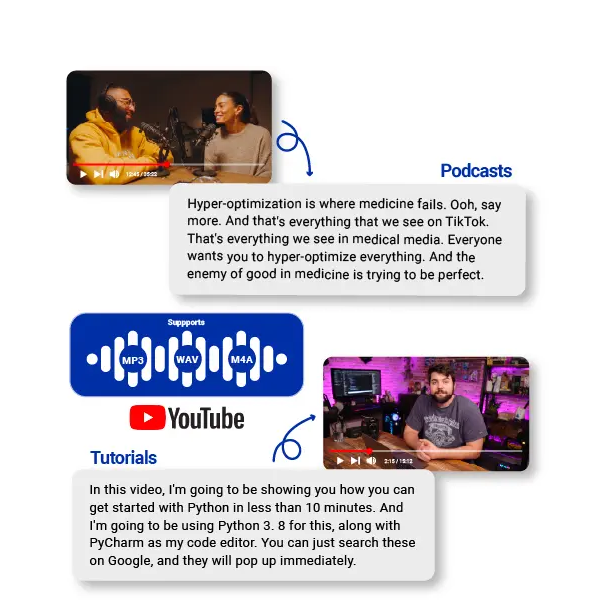
Every day, content creators upload millions of videos to YouTube, yet most struggle with a critical challenge: reaching audiences beyond their native language. You’ve spent hours perfecting your video content, but without transcripts and summaries, you’re leaving engagement and discoverability on the table. Manual transcription is tedious, translation services are expensive, and creating compelling summaries demands time you simply don’t have. The solution lies in AI-powered tools that can translate YouTube video content, generate interactive transcripts, and produce intelligent summaries in minutes rather than days. These technologies break down language barriers, making your content accessible to global viewers while boosting SEO performance through searchable text. Whether you’re a solo creator building an audience or a team managing multiple channels, AI transcription and translation tools transform how you maximize video impact. This guide walks you through practical methods to leverage video transcription tools, create multilingual content, and even convert transcript MP3 files for audio repurposing. You’ll discover actionable steps that turn your existing YouTube library into an accessible, globally-reaching content engine without hiring translators or spending countless hours on manual work.
Why Video Transcripts and AI Summaries Are Non-Negotiable Today
Search engines can’t watch videos, but they devour text. When you add transcripts to your YouTube content, you’re essentially handing Google a roadmap to understand and rank your videos. Research shows that videos with transcripts receive 16% more engagement and significantly higher search rankings than those without. Beyond SEO, transcripts make your content accessible to the 466 million people worldwide with hearing disabilities, ensuring compliance with ADA and WCAG standards that are increasingly mandatory for public-facing content.
AI summaries solve a different but equally critical problem: viewer attention spans. The average person decides whether to watch a video within the first 8 seconds. A compelling summary positioned in your description or social media posts gives potential viewers instant clarity about your content’s value. These summaries also become powerful promotional assets, transforming into tweet threads, LinkedIn posts, and blog introductions without additional writing effort.
The repurposing potential extends even further. Transcripts become source material for comprehensive blog articles, email newsletters, and infographic quotes. Content creators who systematically transcript and summarize their videos report producing 3-5 additional content pieces from a single video with minimal extra work. This multiplication effect turns your YouTube channel into a content engine that feeds every platform in your marketing ecosystem. For international audiences, translated transcripts remove language barriers entirely, opening markets you couldn’t previously reach. A single English video with Spanish, French, and German transcripts instantly triples your addressable audience without recording new footage.
AI-Powered Translation & Summarization: How It Actually Works
Modern AI transcription relies on neural networks trained on millions of hours of audio data across hundreds of languages. These systems use Natural Language Processing (NLP) to identify speech patterns, context clues, and even speaker accents with accuracy rates exceeding 95% for clear audio. Unlike older speech-to-text systems that simply matched phonemes to words, today’s AI models understand grammar structure and semantic meaning, enabling them to distinguish between homophones like “their” and “there” based on surrounding context.

Translation technology has evolved beyond word-for-word substitution. AI-enhanced translation engines analyze entire sentences to preserve idiomatic expressions and cultural nuances that traditional dictionaries miss. When you translate YouTube video content through these systems, the AI considers video topic, tone, and intended audience to select appropriate terminology. A technical tutorial receives different translation treatment than entertainment content, ensuring your message resonates authentically across languages.
AI summarization operates through extractive and abstractive methods. Extractive summarization identifies the most important sentences from your transcript and compiles them into a condensed version. Abstractive summarization goes further, generating new sentences that capture core concepts in fresh language, much like a human would paraphrase key points. Machine learning models trained on millions of documents recognize patterns that signal importance: repeated concepts, concluding statements, and emphasized phrases. Interactive transcripts add another dimension by allowing viewers to click timestamps and jump directly to relevant sections, transforming passive watching into active exploration. This interactivity keeps viewers engaged longer while giving them control over their content consumption experience. Real-time processing capabilities mean you can generate transcripts, translations, and summaries within minutes of uploading a video, eliminating the days-long wait associated with human transcription services.
Step-by-Step: Translate YouTube Videos & Create AI Summaries
Step 1: Choosing Your Video Transcription Tool
The foundation of effective video translation starts with selecting a transcription tool that balances accuracy with your workflow needs. Prioritize platforms offering 90%+ accuracy rates for your primary language, support for at least 50+ languages if you plan global expansion, and native YouTube integration that eliminates manual file uploads. Browser-based solutions like web applications work best for occasional users who need quick results without software installation, while desktop applications provide faster batch processing for creators managing multiple channels. Tools like Owll AI offer streamlined workflows that connect directly to YouTube channels, automatically processing videos through transcription and translation pipelines. Test free tiers first with a representative sample video containing technical terms, multiple speakers, and background music to evaluate real-world performance before committing to subscriptions.
Step 2: Generating and Editing Interactive Transcripts
Once you’ve selected your tool, connect it to your YouTube channel through API authorization or paste your video URL directly into the transcription interface. Most platforms automatically detect language and generate timestamped transcripts within 5-10 minutes for standard-length videos. Review the output in the built-in editor, focusing on proper nouns, technical terminology, and sections with overlapping audio where errors cluster. Use keyboard shortcuts to jump between timestamps and make corrections without disrupting synchronization. Export your finalized transcript in SRT format for YouTube’s native caption system, which preserves timing data and allows viewers to navigate by clicking text. Save additional copies as plain TXT files for translation workflows and VTT format for website embedding with interactive features.
Step 3: AI Summarization Techniques for Maximum Impact
Feed your cleaned transcript into an AI summarization tool, specifying your target length based on platform requirements: 150 characters for social media previews, 300 words for video descriptions, or 800 words for companion blog posts. Configure the tool to prioritize actionable takeaways rather than generic overviews by selecting “key points” or “instructional” modes when available. Extract three to five standout quotes that work as pull-quotes for promotional graphics or tweet content. Compare the generated summary against your original video to ensure it captures your core message without introducing inaccuracies, paying special attention to statistics and claims that require precision. Regenerate with adjusted parameters if the first output feels too generic or misses critical context.
Step 4: Multi-Language Translation Best Practices
Upload your edited English transcript to translation software, selecting target languages based on your analytics data showing where international viewers concentrate. Enable context-aware translation modes that analyze your video’s subject matter, ensuring technical content receives industry-appropriate terminology rather than literal translations. For languages with significant dialect variations like Spanish or Arabic, specify regional preferences matching your target demographics. Process translations in batches of three to five languages simultaneously to maintain efficiency without overwhelming quality review capacity. Recruit native speakers from your audience or freelance platforms to spot-check translated transcripts for cultural appropriateness and readability, focusing their review time on the first two minutes where accuracy matters most for viewer retention.
Step 5: Converting Transcripts to MP3 for Audio Repurposing
Transform your transcript into audio format using text-to-speech platforms that offer natural-sounding voices rather than robotic monotone. Select voice profiles matching your video’s tone: conversational voices for lifestyle content, authoritative tones for educational material, or energetic delivery for entertainment videos. Adjust speaking pace to 150-160 words per minute for optimal comprehension, slower than typical conversation but faster than audiobook narration. Export in MP3 format at 128 kbps for balanced quality and file size, suitable for podcast distribution and accessibility applications. Add the audio version to your video description as a downloadable resource for commuters and visually impaired audiences, or upload to podcast platforms as supplementary content that drives traffic back to your YouTube channel.
Top 3 Tool Categories for Effective Video Localization
All-in-one platforms combine transcription, translation, and summarization in unified dashboards that eliminate the friction of switching between multiple services. These comprehensive solutions automatically sync your YouTube channel, process videos through sequential workflows, and deliver finished transcripts with embedded translations and AI-generated summaries. They typically offer collaborative features for team review and approval processes, making them ideal for agencies and multi-creator channels managing high video volumes.
Specialized AI summary generators focus exclusively on distilling long-form content into digestible formats. These tools excel at producing multiple summary variations optimized for different platforms—concise social media hooks, detailed email newsletter sections, and mid-length blog introductions from the same source transcript. Advanced options allow tone customization, ensuring your summaries match brand voice whether professional, casual, or technical. When paired with a dedicated transcription service, these specialized tools often deliver superior summary quality compared to all-in-one alternatives.
Niche transcript-to-MP3 converters serve creators prioritizing audio accessibility and podcast repurposing. These platforms provide extensive voice libraries with regional accents, emotional inflections, and speaking pace controls that generic text-to-speech engines lack. Premium options include background music integration and audio editing features that transform raw transcript readings into polished audio products. Free tools typically limit voice selection and impose usage caps, while paid subscriptions unlock commercial licensing rights essential for monetized content distribution across podcast networks and audiobook platforms.

Transform Your Content with AI-Powered Video Translation
AI-powered transcription and translation tools have fundamentally changed how content creators connect with global audiences. What once required hiring professional translators and spending weeks on manual work now happens in minutes through automated workflows that maintain quality while slashing costs. By implementing the techniques covered in this guide, you’re not just adding captions to videos—you’re building a sustainable content multiplication system that transforms each upload into dozens of repurposed assets across languages and formats.
The accessibility benefits extend beyond convenience into legal necessity as regulations increasingly mandate inclusive content. Transcripts and summaries ensure your videos reach hearing-impaired viewers, non-native speakers, and anyone consuming content in sound-sensitive environments. Meanwhile, the SEO advantages of searchable text continue compounding over time, driving organic discovery long after publication. Start with your highest-performing videos to maximize immediate impact, then systematically process your back catalog as bandwidth allows. Experiment with different AI tools using free tiers before committing to paid subscriptions, and always validate automated outputs with spot checks to maintain your brand’s quality standards. The creators who embrace these technologies today position themselves as accessible, globally-minded leaders while competitors struggle with outdated manual processes. Your YouTube content already represents significant investment—now make it work harder across every language and platform your audience inhabits.




